· 7 min read
How to Monetize an Infinite Runner
Michail Katkoff
Product Manager at Supercell
Imagine a game where a character runs along an infinite obstacle path. The further the character gets, the more soft currency and points players will get. Players use the points to boast about their top scores and the soft currency to improve their characters. Thus, by eliminating the risk of players ‘running out’ of content, these types of games are a dream come true for modern game developers.
In fact, these infinite runners are making it big in the AppStore. For example Temple Run, by Imangi Studios, has been downloaded 170 million times and Temple Run 2 has been a top stay in the Top 10 grossing on iOS. Another good example would be Subway Surfers by Kiloo. The game was launched on June 2012 and it has established itself as top grossing action title – one update at a time. Then there’s Jetpack Joyride by Halfbrick Studios, which was launched in 2011. It might not have hit those high grossing numbers, but the game sure served as a benchmark for most of the infinite runners to come.
Because of the success that the titles above have had there’s a serious competition within the genre. Some, like the Subway Surfers make it but many others, such as my personal favorite Storm the Train, don’t.
Breaking Down Monetization
As said before, infinite runners aren’t overly tied to new content, which makes them perfect for a free-to-play model. Revenue of a free-to-play title is dependent on three major factors: amount of active players, percentage of paying players and average size of a purchase made.
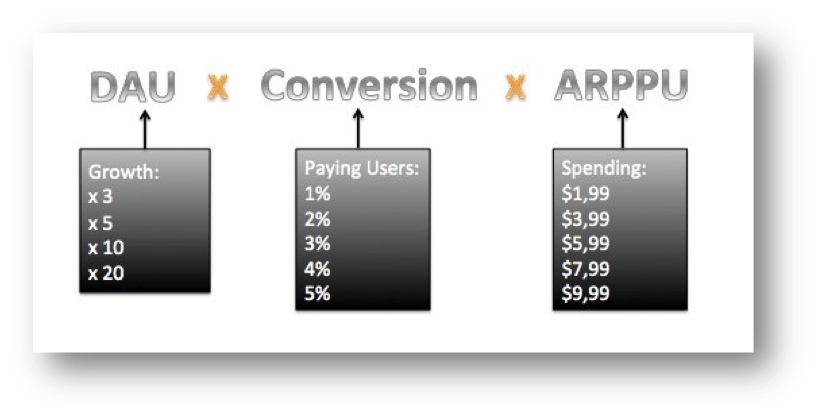
The combination of new players and retained players make the active players base of your game. There are several factors that affect this, such as user acquisition, featuring, cross promotion etc. But in this post I will concentrate on two very specific issues affecting the DAU: Theme and Controls.
I’m not going to talk about average revenue per paying player, as all of the infinite runners have very similar, and thus very low, price points. Instead I’ll take a deeper look on how well different games in this genre create demand that drives players to convert to payers.
1. Theme
Theme is very important in an app store filled with free titles because of two things. Firstly, themes help you to get that download. Think about it. You stumble upon a free pirate game in the AppStore and you instantly relate pirates with ships, guns, treasures, parrots and wooden legs aka. the fun stuff.
Secondly, a strong theme will make your game design so much easier and this will convert into stronger retention. More specifically, in a pirate game you don’t really need to explain to a player what to do. They are there, ready to set sail, do battle at sea and pillage. Kinda comes with the theme of being a pirate.
Theme is also something we developers working on iOS and Android titles tend to often fail at. We too often strive to make games “we would love to play”, even though we might play PC and console titles in the real life. So instead of making games we’d love to play, we make games that “we would play if we wouldn’t have PC or a console”.
But there are also times when we actually succeed with a theme. Mostly this occurs because we combine our nostalgia with what’s “in”. Like Clash of Clans, where you can easily relate to the fantasy world that kind of reminds you of Zelda, Gauntlet or Lord of the Rings.
We also sometimes succeed when developing a game with our loved ones in our mind. Nothing like making a game your wife and children love to play. Even if that game comes out without machine guns, dragons and mech-warriors.
2. Controls
You’d think that every developer takes full advantage of those big, sharp and sensitive touch screens. Yet this isn’t the case. Sometimes we get so into “developing games we’d love to play” that we end up doing virtual joysticks and virtual buttons. You know, to get that Nintendo 8 thing going on. Because for us you just can’t get more casual in gaming than Nintendo 8.
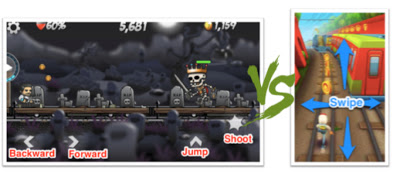
Unless you’re targeting a small segment of male players who feel nostalgic about Nintendo (but who also won’t likely buy any IAPs you’re offering (because they consider boosters as cheating), you should really consider swiping, pinching and pointing as a primary control mechanics.
Also, try to make it so that players can play your game with one hand only. You want them to play your game while commuting and having one hand free makes it a lot safer to do so.
3. Sense of Progress
Fast tracking progress is what monetizes in free-to-play games. Simply put, after a good game start, player progress should slow dramatically. Accustomed to the rapid progress and driven by the
goals which lie ahead in the game, players tend to use real money to fast track their progress.
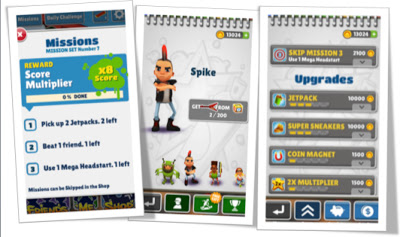
When it comes to progression, infinite runners are pretty much all clones. Each run earns the player soft currency, which is then used to enhance player attributes or to unlock new characters.
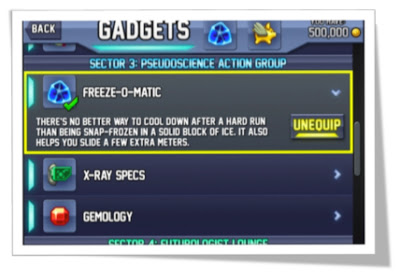
4. Competition
A great way to create demand for fast tracking the progress is to encourage players to compare their progress with one another. At the end of the day it doesn’t really matter what your top score is in a Subway Surfer game. It is only a game you play now and then. But once you see your friend’s score and try to beat it just to see it beaten, things are starting to get serious…
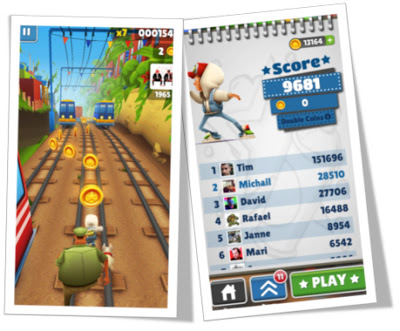
5. Ads
With sometimes only less than one percent of your active player base paying, you need to come up with ways to monetize those non-paying users. One solid way is to use ads.
 Normally the player sees only one add per session in Subway Surfers. But these interstitials promoting other games are high earners.
Normally the player sees only one add per session in Subway Surfers. But these interstitials promoting other games are high earners.
Now be sure not to go crazy with the ads and interstitials, because they can easily turn your game into a Christmas tree. Choose a screen or two and limit your ads to that space. You can also think about offer walls, where you can reward player with in-game currency for watching an ad.
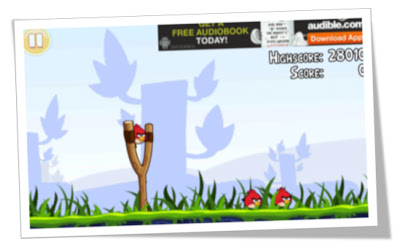
Why not go all the way to F2P?
Even though the majority of infinite runners are free-to-play, they are still having a hard job in hitting and holding on to top grossing positions. This is mainly because none of them have any restriction mechanics. There’s no energy mechanics and no timers.
Usually game developers say that people hate restriction mechanics – and they are right. But I like to use the cake metaphor: If you eat a piece of great cake, you’ll want more tomorrow. But if you eat the whole delicious cake today, I doubt you’ll want more of it tomorrow.
So look at your game as a delicious cake. Offer pieces of it, but don’t give the whole cake at once. That will only make your customers sick.